

|
|
|
|
|
|
|
|
|
VENTSThe BasicsVents in Thick Shells Vent Location In A Tom Venting Acrylics Venting Kick Drums Removing Vents Alternate Vent Styles |
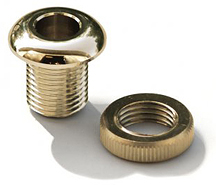
Photo courtesy of drumsonsale.com |
|
The Basics There are two basic types of air vent hardware - one is a grommet, the other is a screw type. The screw type is easier to remove later if needed, but may require tightening from time to time. There are also two basic sizes - the most common is 1/2", and there is also a 3/8" for smaller drums such as piccolos. But of course, you can vent without hardware. Large vents, in particular, are nothing more than holes drilled in the wood. Vents in Thick Shells hippybaker: I made a 3/4" shell, and it never even occurred to me until I went to buy hardware that standard screw in and press in vents wont work on a shell so thick. And I just thought of it now, as I was typing how I am going to vent this drum. I am going to make a very small hole at every lug, near the edge.. Just past where a head would go. Casper: In my .5" thick birch pic. snare I just countersunk the rear nut for the vent. Makes it look more low profile and I was able to use a standard sized .5" threaded vent. sadolcourt: You can glue in the vent, perhaps just use some CA glue under the rim, where it meets the shell. If you ever needed to remove the vent, use the CA glue solvent. Uh, test that first....it's just a theory! The vent is little more than a nice trim ring; really, you need only the business end, and enough of the body to get it glued in. Some 18 or 20 mm long 4 mm screws should set you right, then you won't have to counter-sink. A thin washer against the shell, a star type lock washer, and screw it down - you're done. hippybaker: Perhaps All-Star (a custom lug maker listed on the Suppliers Page) could whip up such a thing pretty easily. I never even thought of that. Vent Location In A Tom PDGood: Does anyone have a suggestion for the location of the vent hole on a mounted tom? rhjanes: Well, most would just center it top to bottom and also between two lugs. Doing that, it always looks in proportion. Another idea, is to center between two lugs, but then just down off the top rim about 2 inches. Doing that, you can hid it behind the mount. But then if you don't want it to show, just center it and then no matter how you mount it, face the vent back at the drummer. koko: Opinions differ on this, I have seen two major "winning" places. Nodal point, at 22.22% height/bottom of the shell or center. I did both and am not able to tell a difference, so basically it is up to you. I've hidden some under the strainer on my snares. Like Ray already suggested, you can do this with your toms too. I have found no vent holes not a option, toms seem to have a higher pitch and more "ringy" overtones. fienddrummer: I always hide mine under the rims mount. So I center it between two lugs and place the suspension bracket over it. I just like the clean look that it gives. Venting Acrylics AndyGTC: Would you vent an acrylic snare? disinformation: Ok, first things first. Assemble the drum and try it. Don't vent it before you have played it complete, as even though it may be the same as the next acrylic, you never know the sound you are going to get with a certain combination of heads and tensioning etc so start with that. If it is not the sound you are looking for then maybe start with a standard 1/2" vent or a few single 1/8" holes in line with the t rods at the bottom end to keep the shell looking tidy. Remember, it's an awful lot more difficult to fill those holes up once they are drilled, so what ever you decide to do, go carefully and take it step by step. This is what I do with the acrylics we do unless some one is adament they want a swiss cheese snare for the look !!!!! (Seriously - we get it all the time. I like the look of the vented snare with 4" vents :s). Woodrow: I experimented with venting and didn't like it. I suggest one vent first by the butt plate, then add a second (only if needed) by the strainer. If that doesn't work... quit! It won't get better! Vents don't make a drum better as far as I have found in my experience. Enraged Panda: From what I've played..you have to have a lot of mass (shell thickness) in order for vents to sound good. BadgerDrums: How do you do this without melting, burning the acrylic? How do you polish the vents after you drill and sand them? Would you use a forstner or a hole saw? shiloh: There are bits designed for boring holes in acrylic. Go to your local glass shop and ask, regular bits may cause hair line fractures around the holes. Check into this before proceeding. Venting Kick Drums RBOD: Is there any real need for a vent hole on a bass drum with a ported reso? It seems silly to have a 1/2" vent hole when there is a 6" hole in the front. Is there anything I'm missing or do most companys put them in just in case people use a solid reso? PDGood: You are right on all counts. feynmans_oj: I am going to start building myself a bass drum soon, and was wondering what people thought about placement/size/number of vent holes. I have read some various articles, basically it sounds like size doesn't matter too much (as far as a 1/2 inch vs. 3/8 inch hole is concerned), placement is a judgment call (although I have heard that holes closer to the "nodes" and holes closer to the resonant head improve sound), and that numbers can be anywhere from 1-5. What is the recommended specs? rhjanes: You don't have to vent. You can hide a .5 inch vent, down low. Also, if you have a ported reso-head, then a vent in the shell is useless. Mixmup: I guess in theory that placing a vent right on a node would expel more energy that isn't part of the resonance of the drum. Working out where the nodes are is anyones guess (I'll bet the maths are ugly - elasticity coefficients of the heads???) - this will probably change when you tune the drum up or down also. jeroen: In theory this would be The exact middle or at 22.22% (there are more, of course). But as you say: Indeed nodes are pitch related feynmans_oj: Well, physics would dictate that every drum shell has a natural resonant frequency, and so whenever it was hit the shell would resonate at the frequency. The nodes then, are where the shell isn't vibrating (as opposed to anti-nodes, which are where the waves move the most), which is why it is theoretically sound to drill where the shell is not vibrating. But for vent holes to be the most effective at venting, perhaps they should actually be located at the anti-nodes? My guess is that the tension in the heads actually affects the pitch the most, whereas the shell resonance is what affects the timbre of the sound. The problem would seem to be that with anything, there are all sorts of harmonics vibrating at the same time, making finding the location of the nodes somewhat more difficult. skaman: You arent going to blow out a head even if you put no vent hole. The lugs provide plenty of venting to begin with. mixmup: I know my bass drum sounds much better with both tom arms in (to block up the holes) which makes me wonder if it wold be better to seal the drum up completely. Also, the vents on snares make for an interesting sound when close miced . Just be sure to have the puff of air go across in front of you SM57 or whatever - not firing directly into it. PDGood: If your resonant (front) head is vented or if you're not using one, or if there are any holes for tom attachments, then it is already vented. To a lesser extent, holes where the spurs are and where the lugs are can also be providing venting - depending upon how well those holes are sealed. Removing Vents mikeasaurus rex: First of all, I started on a rack tom and realized I couldn't get the dang metal grommet off. Help with that! rhjanes: Usually, if they are press in, there is a lip on the inside. You slide a thin flat blade screw driver under it and pry up. Work around the edge, then it pushes out. hippybaker: For the gromett, I dont know about the newer style, but the old Pearl style can be easily removed by using the skinny end of a drumstick, from the inside of the shell, and tapping/wiggling it out. Once it gives, they come pretty easy. I find, if you try to pry it with a screwdriver or something, you tend to scar the inside of the shell. |
|
Alternate Vent Styles |
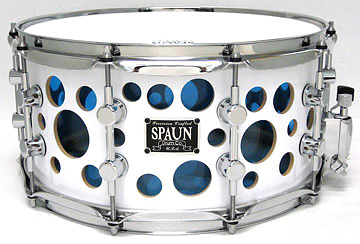
Photo courtesy of Spaun Drums |
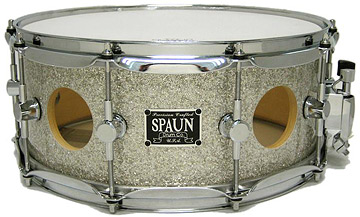
Photo courtesy of Spaun Drums |
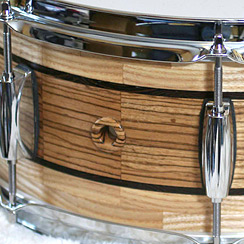
Photo courtesy of Keith Thom |
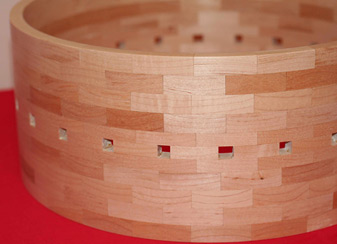
Photo courtesy of Keith Thom |
|
kirschdrums: (In response to someone who needed vents but didn't have a drum parts supply store nearby.) Check out this little do-dad. It's a plumbing seat. They go in your faucet to control the amount of water that comes out. You can find 'em at any hardware store. They come in about 50 different sizes and shapes and have chrome or brass finish. The kind I use come in packs of two for $2.95. You'll need the tool but they're only about 5 bones. It's good to use a tap in the shell hole but I've carefully installed 'em without one. Best part about these is no waiting and a unique look. 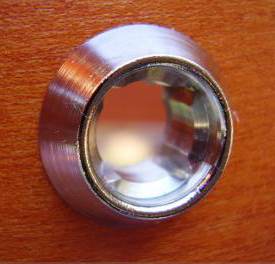
|